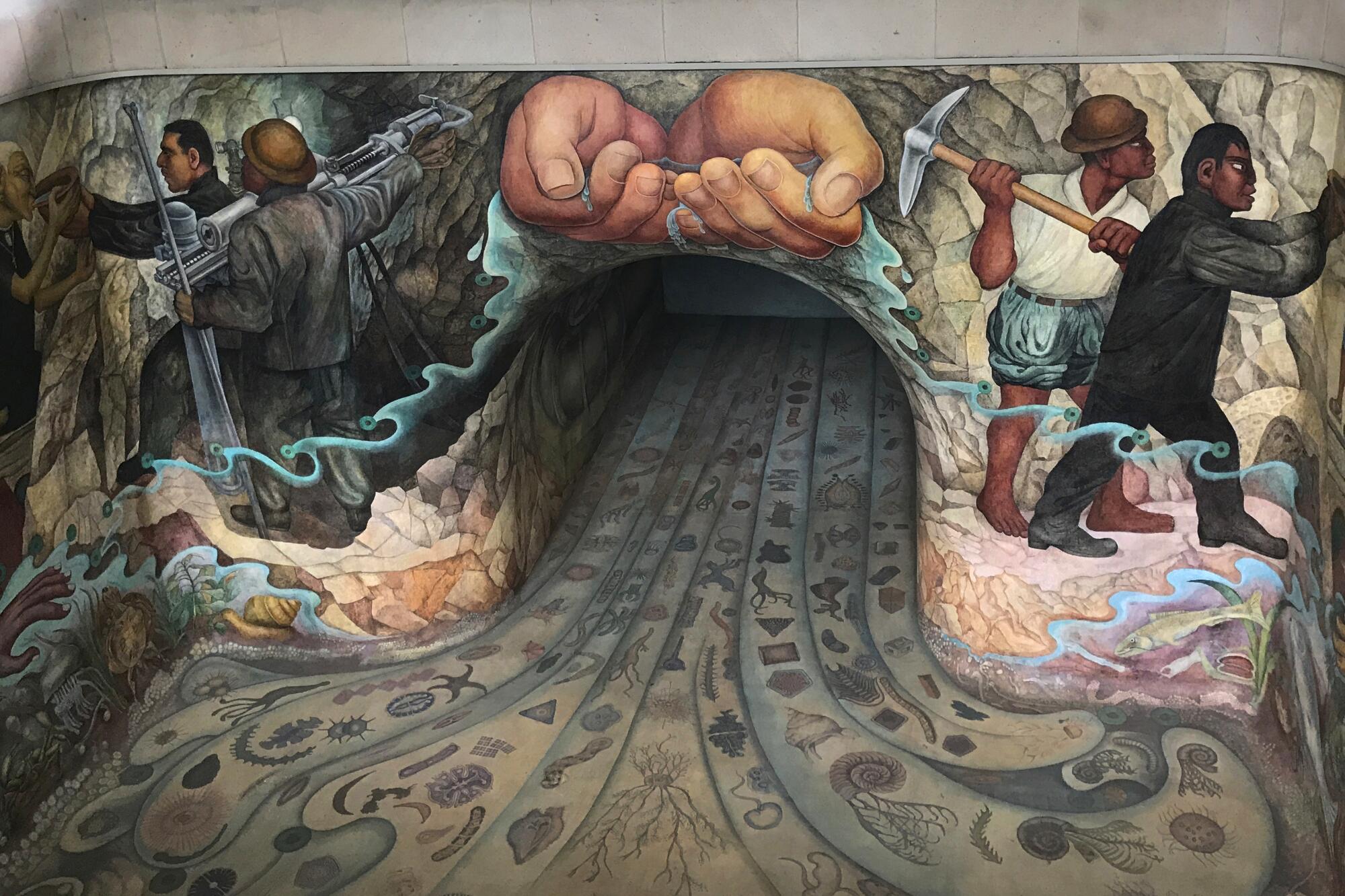
- Share via
MEXICO CITY — When Reina Cervantes Trejo heard the truck, gears grinding as it climbed the street to her house, she rushed outside.
“Thanks to our good Lord!” she said. “The water has finally arrived!”
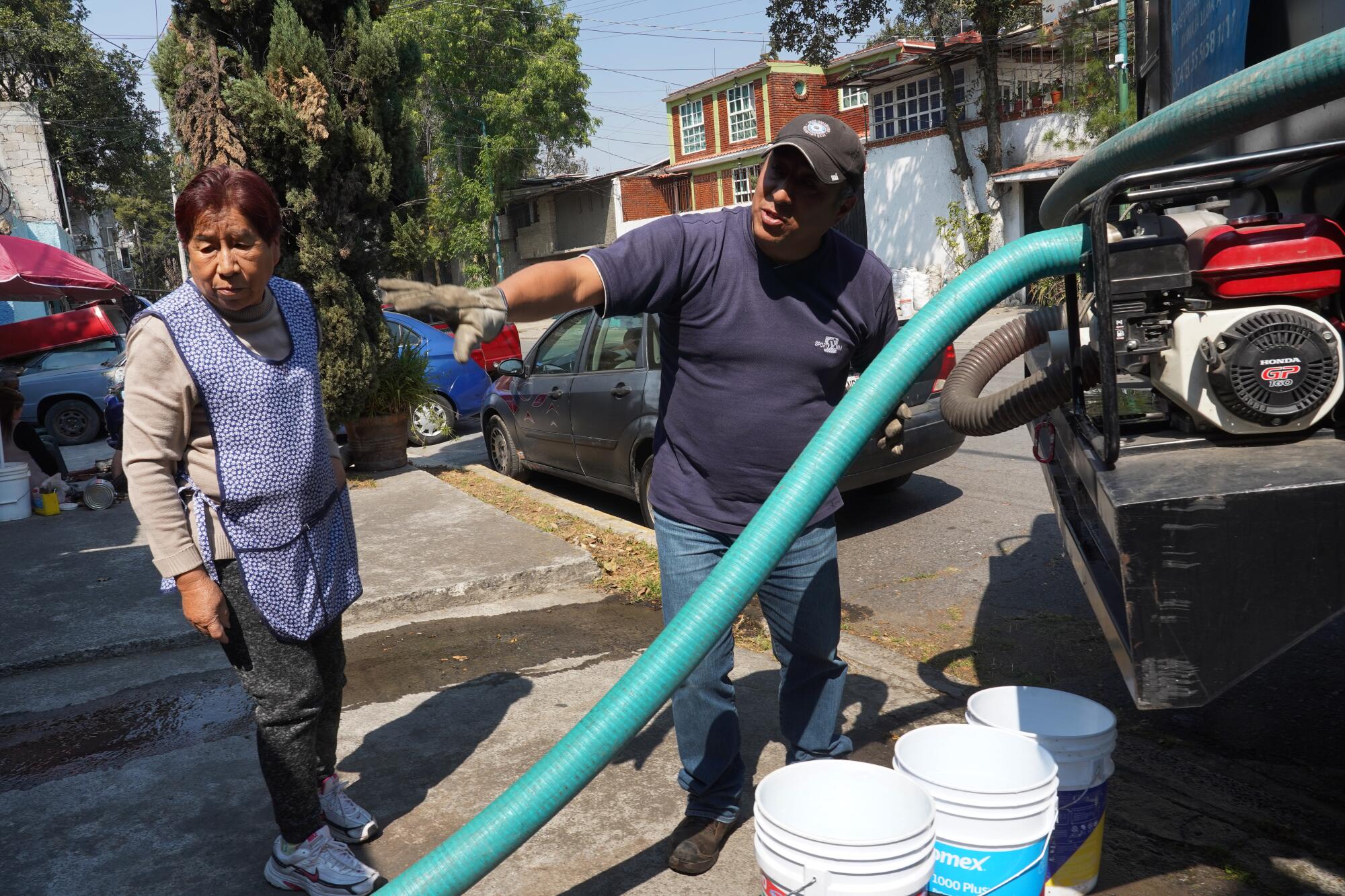
Cervantes and her husband hurried to help the driver, Fredy Romero, as he yanked hoses from the truck to fill up a cistern and a hodgepodge of plastic buckets, pails and kitchen pots the couple had assembled on their patio.
The taps had dried up weeks ago, and Cervantes’ daughter had been calling the city nearly every day, pleading for the water trucks to come to their working-class neighborhood in the city’s south.
Cervantes desperately needed the water to bathe her father, who recently turned 100, and keep his clothes clean.
“I don’t like to see my father looking dirty and uncomfortable,” said Cervantes, 68. “He doesn’t deserve that, especially at his age. It is no way to live.”
Water shortages are becoming a way of life in cities across the globe — Los Angeles; Cape Town, South Africa; Jakarta, Indonesia; and many more — as climate change worsens and authorities often pipe in water from ever-more-distant sources.
“Water sources are depleted around the world,” said Victoria Beard, a professor of city and regional planning at Cornell University. “Every year, more cities will face ‘Day Zero,’ with no water in their piped systems.”
Mexico City — founded by the Aztecs on an island amid lakes, with a rainy season that brought torrents and flooding — might have been an exception. For decades, the focus has been getting rid of water, not capturing it.
But a grim convergence of factors — including runaway growth, official indifference, faulty infrastructure, rising temperatures and reduced rainfall — have left this mega-city at a tipping point after years of mostly unheeded warnings. Distant reservoirs and underground wells are drying up as leaders belatedly confront an existential dilemma.
“The water shortage has really intensified this year,” said Claudia Rojas Serna, a hydraulic engineer at the capital’s Autonomous Metropolitan University. “What we are going through now is as bad as we have seen.”

Now the ubiquitous water tankers are a lifeline as the 22 million people in this metropolitan area wait for rain and a little relief.
::
The jacarandas are in bloom across Mexico City, their bluish-purple flowers almost mocking in the stifling, polluted air of the dry season. Amid the season’s shortages, officials have resorted to rationing. Millions now have only intermittent service — sometimes an hour a week or less of running water, residents say.

The wealthy can buy water from private suppliers. But that’s not an option for most residents. For them, it takes a predawn scramble to reach sign-up sites to get their names on handwritten lists for the tanker trucks, known as pipas, or pipes.
“Without water, what do we do?” said Alejandra Rodríguez, 53, noting that a recent tanker was the first to arrive in almost two months at her Tlalpan housing complex, home to four families. “When I saw that the water truck was finally coming, I jumped for joy.”
In a national election year, the water crisis has taken on a decidedly political cast, as protesters demanding water regularly block streets and highways.
Claudia Sheinbaum, a Berkeley-educated scientist who is the ruling-party candidate for president, boasts of having improved Mexico City’s besieged water department as mayor from 2018 to 2023. But the opposition has dared her to publicly drink the water brought by tanker trucks, which the city says is potable.
Most residents say they drink only bottled water because they don’t trust city water, whether it comes from trucks or taps in their homes. And, they add, with the current shortages, many have been forced to rely on the expensive bottled water for washing as well, recycling it later to flush toilets.
Critics of President Andrés Manuel López Obrador, Sheinbaum’s mentor, warn ominously of a dry future.
“We are at the edge of the precipice,” José Luis Luege Tamargo, a former national water commission director now affiliated with the opposition, told a radio interviewer. “We are going to find ourselves in a situation that we won’t be able to respond to.”
Allies of the left-wing president dismiss such talk as alarmist propaganda.
“There is no Day Zero, that’s a falsehood, fake news from the conservative opposition,” Mexico City Mayor Martí Batres, a member of the ruling Morena party, told reporters last month. “The service of drinkable water in Mexico City is guaranteed in the short, medium and long term.”
Scientists say a Day Zero anytime soon is unlikely. Even if persistent drought dries up the reservoirs outside town, the city still has reserves in its shrinking underground aquifer system, with hopes that coming rains will replace some of the year’s losses and stave off disaster. But no one one disputes that Mexico City’s water shortfall is getting worse.
The deficiency, experts say, stems from structural and climate issues that transcend politics.
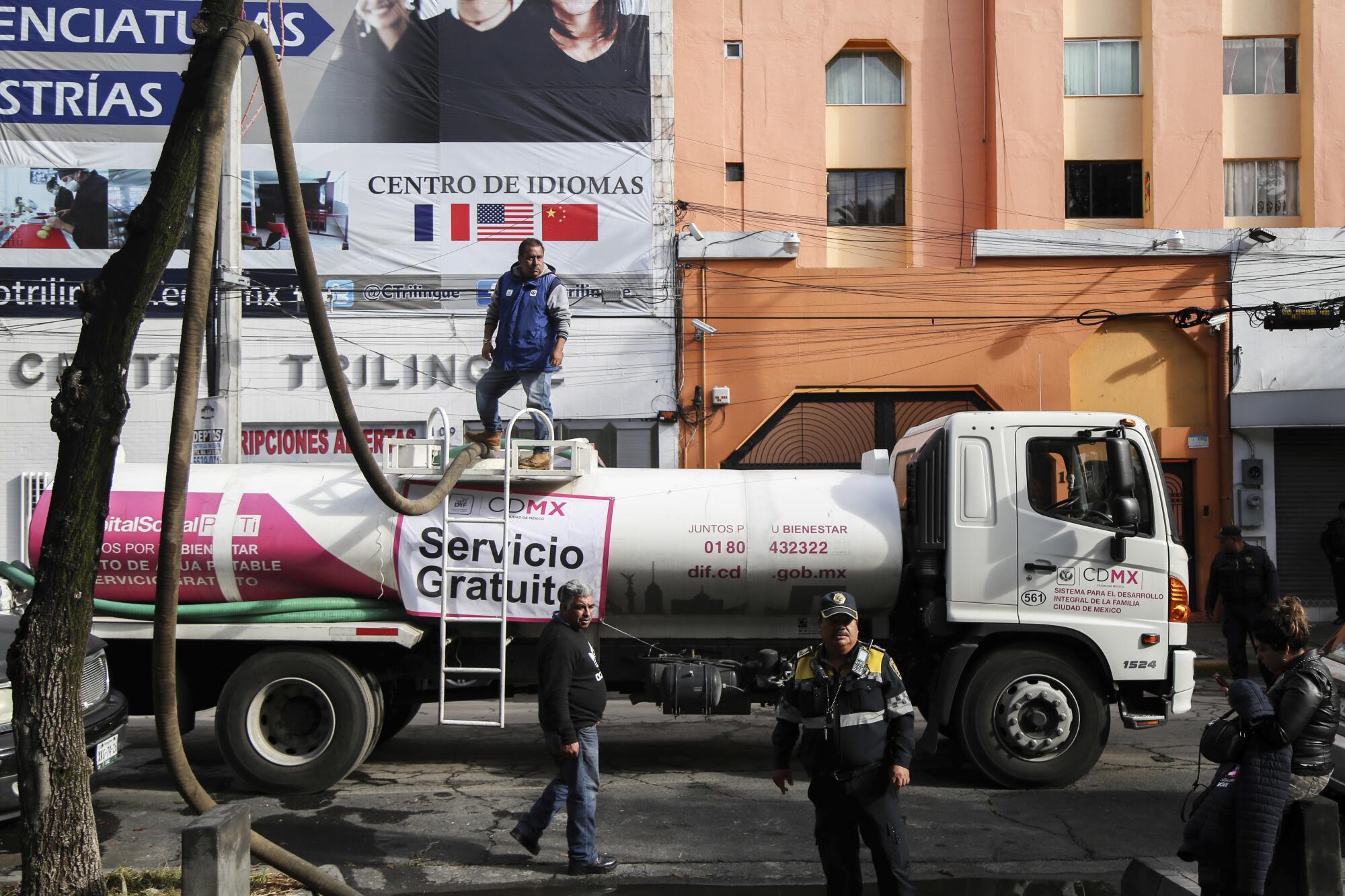
Last year was among Mexico City’s hottest and driest on record. Scientists cite El Niño conditions linked to climate change.
Drought and evaporation have left the far-flung Cutzamala reservoir system — which supplies Mexico City and environs with about one-third of its water — at less than 40% of capacity, almost half of historic levels at this time of year. Authorities began curbing distributions last year.
And massive leaks in Mexico City’s crumbling, 8,000-mile-long pipeline grid, regularly damaged in seismic shifts, further drain reserves. An extraordinary 30% to 40% of the water pumped into the aging system is lost to leaks and another culprit — illicit connections. Lawmakers have vowed to crack down on what they say is a growing number of individuals and gangs tapping illegally into water ducts.
“We cannot allow huachicoleo,” Mayor Batres told reporters in January, using a term normally reserved for clandestine siphoning of gasoline from pipelines.
But many are desperate, as the water tankers — most holding about 2,600 gallons — quickly run out as they make their rounds to scorched colonias such as the outlying precincts in the Iztapalapa district, home to almost 2 million people.
“There was no water left for us,” said Jerónimo Gómez Cruz, 79, who steadied himself with a cane as he forlornly watched a water truck climb past his home on a dirt street.
Drivers are required to adhere to an official, compiled list of addresses of people who have waited for days or weeks.
“People blame us for the lack of water, but it’s not our fault,” said Moisés Pérez Medina, 27, maneuvering a water truck in Iztapalapa and deftly wielding hoses as his companion for the day, his 5-year-old son, Giovanny, watched proudly. “I’m from here, Iztapalapa, and am just trying to help people and make a living for my family.”
::
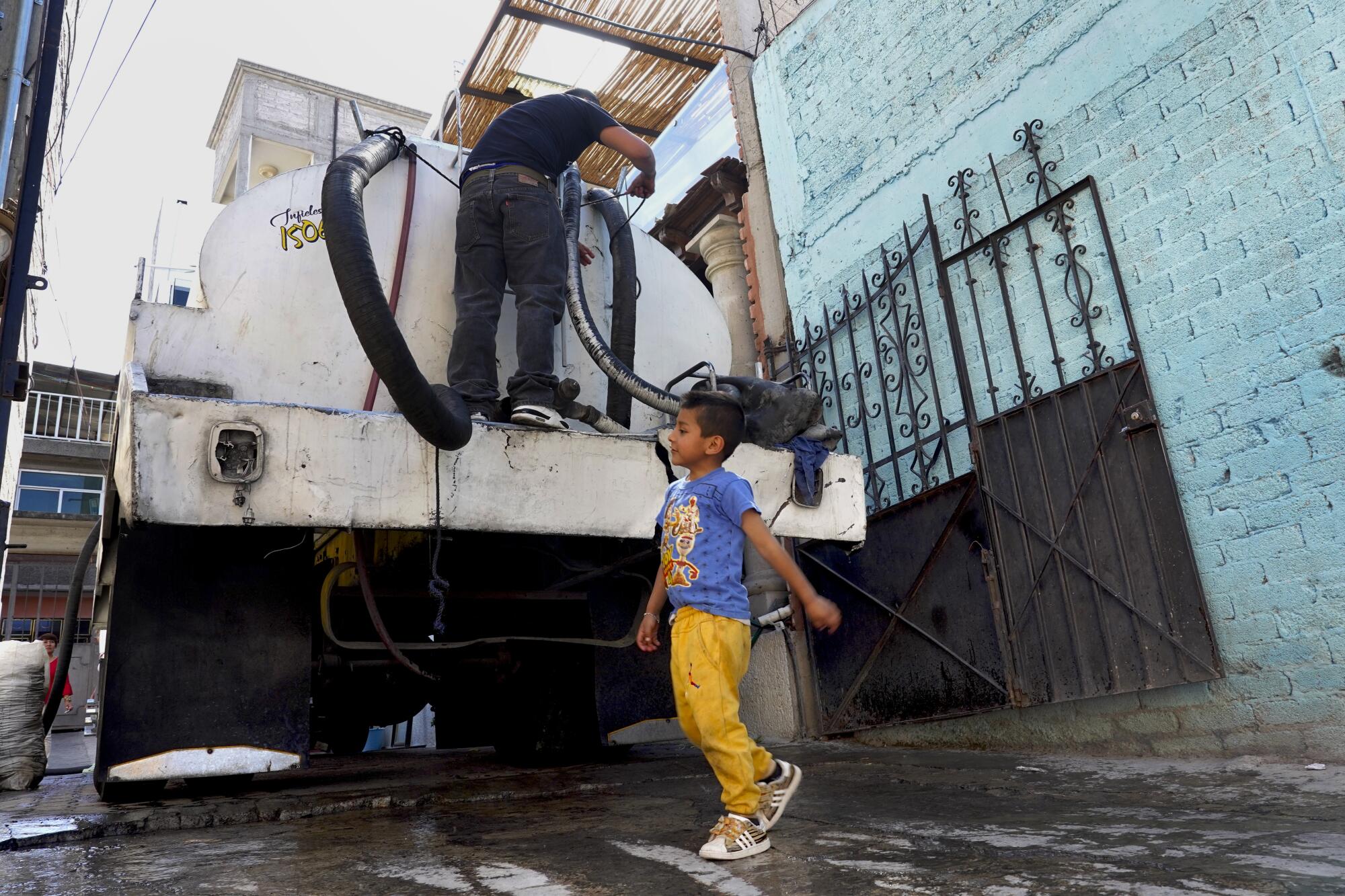
The Aztecs are sometimes referred to as the hydraulic wizards of Mesoamerica.
The Indigenous founders of Tenochtitlan, now Mexico City, built their capital on an island amid a series of lakes, a strategic setting that provided both security and access to water. They crafted a virtuoso matrix of canals, dikes, navigation channels, causeways, aqueducts and floating vegetable gardens (chinampas) — all in a mountain valley almost a mile and a half above sea level where rain, while often torrential, lasts only a few months.
Although they constructed sophisticated water systems, the Mexica, as the Aztecs were known, hedged their bets. After all, they inhabited a precarious cosmos where the prospect of drought menaced entire civilizations. Among the Aztecs’ most revered divinities — and the beneficiary of human sacrifices — was Tláloc, the god of rain.
But Spanish invaders obliterated the Aztec capital in the 16th century, smashing dikes and other Indigenous hydraulic works. Thus began a protracted process of draining lakes and waterways to transform the glittering island city into a European-like capital planted on terra firma.

As the city expanded, under both Spanish and Mexican rule, engineers wrestled with a vexing question: how to curb the often-catastrophic floods that regularly inundated the city, typically between May and October. Much of the post-Aztec water infrastructure was focused on finding ways to expel, not save, water.
Rainy season downpours still flood streets and highways each year, sending water cascading into subway tunnels.
“All of the great hydraulic works of this city have been designed to get the water out to avoiding flooding,” said Luege, the former national water commissioner. “The paradox is that we are going to be left without water.”
When it was inaugurated in 1900, the Great Drainage Canal of the Valley of Mexico, three centuries in the making, was considered an epochal engineering feat. The canal still carries sewage, mixed with rainwater, away from the city on a malodorous, 29-mile course.
“There has been a lack of strategy, not only in the last five years, but in the last 150 years or more,” said Eric Morales, a hydrologist at the National Autonomous University of Mexico. “Since the beginning, little thought has been given to separating rainwater from sewage.”
Mexico City still gets about 70% of its water from wells reaching deeper and deeper into a sprawling underground aquifer network. But centuries of unchecked development have depleted the subterranean bounty. Rain falling on urban expanses is channeled into drainage conduits, squandered.
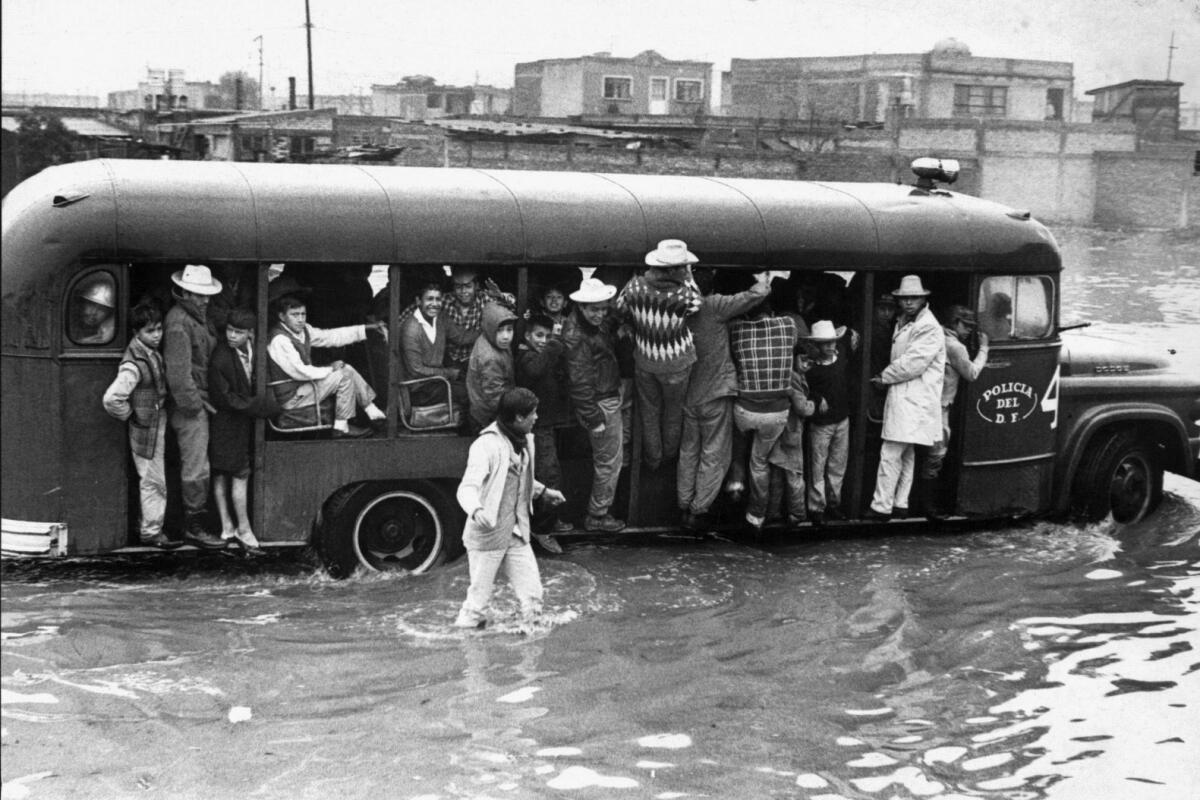
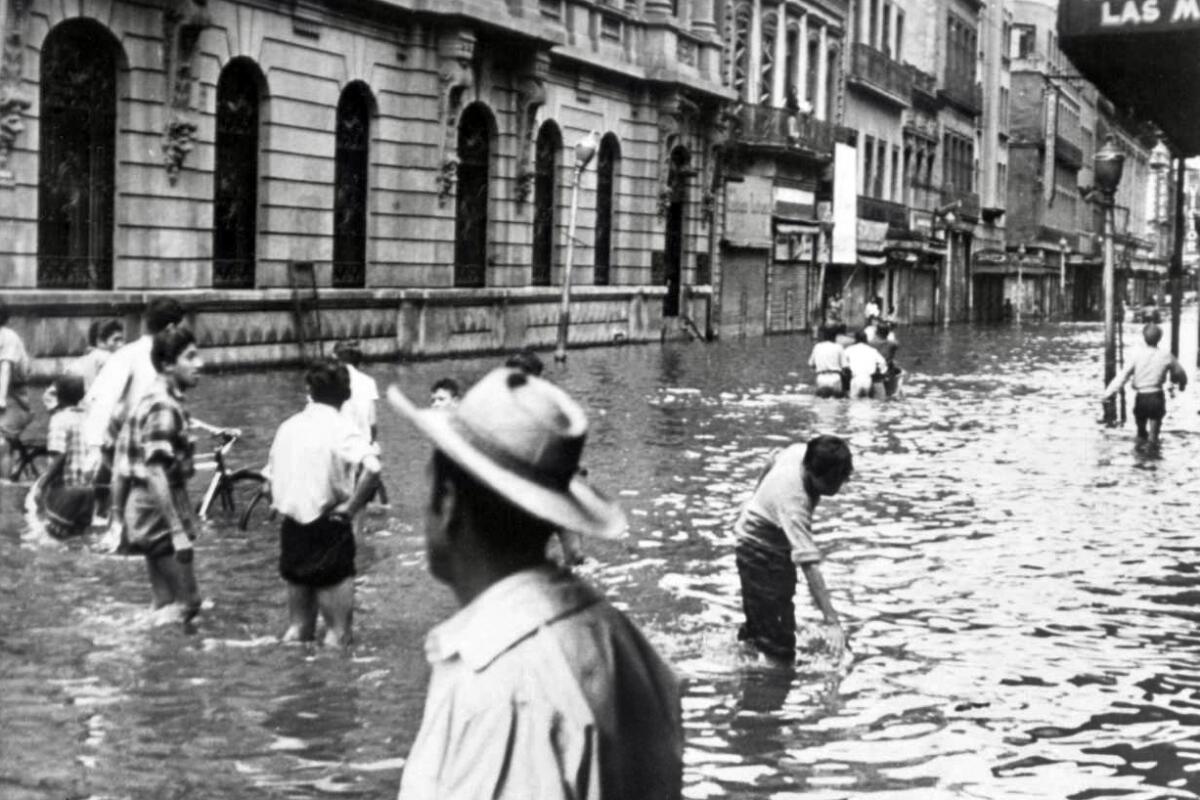
1. Mexico City suffers from water shortages, especially in the dry season, yet has long flooded in the rainy season. A police bus navigates through flooded streets as it evacuates residents from Mexico City’s Santa Rosa neighborhood in 1967. 2. People wade along a downtown Mexico City street in July 1950. (Left, courtesy of National Institute of Historic Studies on the Revolutions of Mexico. Right, courtesy of Museum Archive of Photography, Mexico City )
“Cities are basically nonporous environments,” said Beard, the Cornell professor. “Areas that need to be recharging the water table are smothered in cement and concrete.”
And, on the mountains flanking Mexico City, deforestation — a product of haphazard development and clandestine logging — is exacerbating the loss. The tree root pathways that curb soil erosion and help capture rain and snowmelt are being ripped out.
“The aquifer is being over-exploited,” Morales said. “We are taking out twice as much each year as can be recharged.”
As the aquifer loses water, Mexico City sinks — as much as 15 to 20 inches a year in some areas — in a process known as subsidence.
As vast quantities of water are extracted, the ground can often no longer hold the weight of the urban sprawl above, resulting in buckling streets, sudden sinkholes and the famously crooked appearance of some of downtown Mexico City’s most stately buildings — including the National Palace, the Metropolitan Cathedral and the Palace of Bellas Artes.
The neighborhood around the Angel of Independence statue along the elegant Paseo de la Reforma sank so much that authorities had to add more steps just to reach the base of the monument.
Meanwhile academics, politicians and others regularly propose monumental, multibillion-dollar projects to preserve Mexico City’s water — to patch the pipeline leaks and build new systems to harvest and recycle rain — while also advocating managed growth, conservation and the expansion of green areas.
“If we were able to appropriate all the water, there would be no water crisis in Mexico City,” said David Barkin, an economist at Autonomous Metropolitan University. “This could be a green city.”
But Barkin said that would mean “a tremendous urban redesign. It would require massive urban reorientation of people — and huge investments.”
President López Obrador brushes off talk of a water crisis. He speaks confidently of fixing the leaks and drilling new wells in distant locales and laying down pipelines at ever-greater distances.
“We understand very well the situation of the water in the city,” the president told reporters recently. “We are taking care of it.”
::

In the contemporary, helter-skelter sweep of Mexico City, there is one place — in the southern borough of Xochimilco — where a vision of a watery, pre-Columbian capital may still be imagined. Here, residents travel via boat and oar along miles of tree-lined canals, transporting flowers, vegetables and other products harvested on the artificial islands known as chinampas that were a mainstay of Aztec agriculture. Pelicans and ducks float alongside farmers’ boats and the colorful trajineras that transport tourists.
But even in this incongruously pastoral setting, shortages cast a shadow. Studies show that Xochimilco’s canals are shrinking and heavily contaminated.
“When I first came here, the water was crystal clear,” said Fortunato Dionisio, 48, who has planted on chinampas for three decades and was recently hauling a load of ornamental plants to market. “Now it’s very dirty and the level of the canals is much lower.”
A few miles away, in the Xochimilco village of Santa Cruz Acalpixca — known in Aztec times as “the place where canoes are watched over” — most homes lack plumbing. Residents draw on a public well, powered with an electric pump. Some still use burros to lug water from the well uphill to the village.
“I’ve been doing this for more than 30 years, and it has kept me healthy,” said Ana María Sandoval, 53, as she embarked on the climb with four 5¼-gallon containers of well water lashed to her donkey, Pancho.
She guided Pancho up a treacherous final stretch leading to her home, stopping to offer him water.
In recent years, Sandoval said, she has seen ever-larger numbers of users tapping into the well. Some fill up huge containers and load them in pickups, driving off to sell them. She worries it will run dry someday.
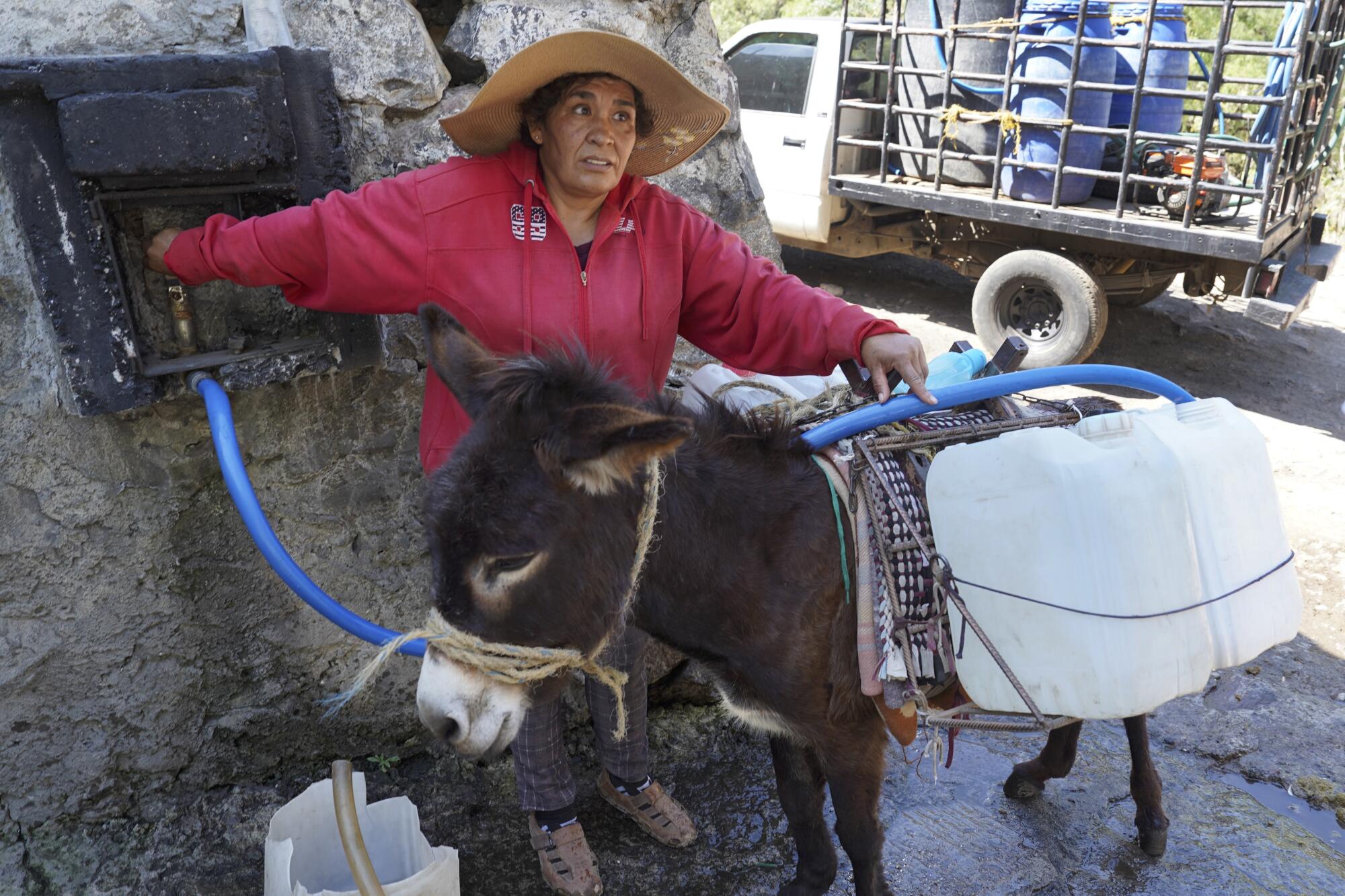
“People suffer a lot for water here,” Sandoval said. “But the problem in Mexico City is not the water. We have plenty of water. The problem is that so much water is lost, wasted. There’s a lot of greed. That is the real pity.”
She grasped Pancho’s lead rope in one hand and a wooden staff (and burro motivator) in her other. She continued along the dirt road, lined by cactus and brush, passed occasionally by motorbikes and battered Volkswagen Beetles, the water carried on Pancho’s sides sloshing as the burro trudged home.
Special correspondents Cecilia Sánchez Vidal and Liliana Nieto del Río contributed to this report.
More to Read
Sign up for Essential California
The most important California stories and recommendations in your inbox every morning.
You may occasionally receive promotional content from the Los Angeles Times.













